

Is Human Activity Primarily Responsible for Global Climate Change? - Climate Change Debate - ProCon.org. PRO (yes) The National Aeronautics and Space Administration (NASA), in the "Climate Change: How Do We Know?
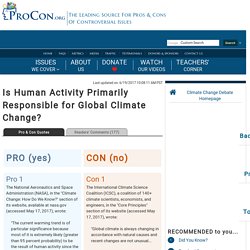
" section of its website, available at nasa.gov (accessed May 17, 2017), wrote: "The current warming trend is of particular significance because most of it is extremely likely (greater than 95 percent probability) to be the result of human activity since the mid-20th century and proceeding at a rate that is unprecedented over decades to millennia... - Global sea level rose about 8 inches in the last century. The rate in the last two decades, however, is nearly double that of the last century. The Parasite that Becomes a Tongue. In warm Pacific waters from the Gulf of California to the Gulf of Guayaquil thrives a parasite that has a very twisted relationship with its host.

The Tongue-Eating Louse A member of the family Cymothoidae, the tiny Cymothoa exigua, or tongue eating louse, enters its victim through the gills. Once inside, the female latches onto the base of the fish’s tongue, while the male attaches behind her or on the gills. Through her front claws, she sucks the fish’s blood, which causes the tongue to die and drop off. She will then re-attach, this time to the tongue stub, effectively becoming its replacement. Each infested fish almost always has more than one mating pair in its mouth. Amazingly, other than losing a tongue, infected fish seem to suffer little from the louse infestation. News. You have probably participated in or seen a contest where you had to guess the number of jelly beans in a jar to win.
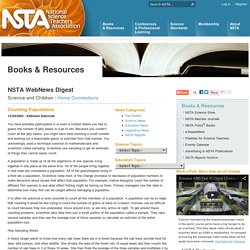
Because you couldn’t count all the jelly beans, you might have tried counting a small number and working out a reasonable guess or estimate from that number. You unknowingly used a technique common to mathematicians and scientists called sampling. Scientists use sampling to get an estimate of things they cannot easily count. A population is made up of all the organisms of one species living together in one place at the same time.
All of the people living together in one town are considered a population. It is often not practical or even possible to count all the members of a population. Introduction to transport in plants GCSE. Ed Yong’s TED Talk: Suicidal crickets, zombie roaches and other parasite tales. “Are there any parasites that are influencing our behaviour without us knowing it?”

When I started this blog back in 2007, Ed Yong was a fledgling science writer gaining an audience with his Not Exactly Rocket Science wordpress blog; clear and engaging online articles that opened up primary research to a wider audience. You’ll find many links to his writing throughout this site, connecting the concepts of the IB Biology course to current science and ‘the wow beat’.
He has since had a book and is resident at NatGeo’s Phenomena Salon, after moving through Science Blogs and Discover. He continues to inspire me as a writer and this week he gave his TED Talk, a funny and fact-packed tour of the sinister side of parasites. Enjoy! If you don’t already, you should subscribe to the Phenomena blogs, and if you’re a teacher or student whose schedule are as packed a mine, I highly recommend Ed’s weekly ‘Missing Links‘ roundup of science news and writing – they make for my Sunday morning reading! Food Web Game. Welcome to the Ocean Tracks development site! What's behind a 6-mile-long fish kill near Monett. Www.nasa.gov/pdf/544871main_E3_Solar_Oven_C4_Final.pdf. Www.epa.gov/OUST/cat/mason.pdf. Www.bbsrc.ac.uk/web/FILES/Resources/practical-biofuel-activities-complete.pdf. City of Palo Alto - Environmental Compliance - Sewer Science - Materials. Wastewater Laboratory for High School Students.
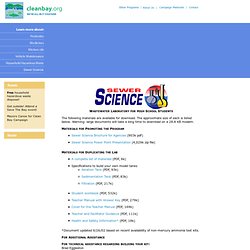
Soilweb.landfood.ubc.ca/youth/images/pdfs/soil-school-activities-nov27-dy.pdf. Www.nhn.ou.edu/assets/reu/Soils_Module.pdf. Www.soils4teachers.org/files/s4t/lessons/perkin-through.pdf. Soil. A Student's Guide to Global Climate Change. Climate is what we expect, weather is what we get. – Mark Twain Climate refers to the average weather conditions in a certain place over many years.
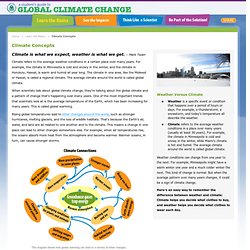
For example, the climate in Minnesota is cold and snowy in the winter, and the climate in Honolulu, Hawaii, is warm and humid all year long. The climate in one area, like the Midwest or Hawaii, is called a regional climate. The average climate around the world is called global climate. When scientists talk about global climate change, they're talking about the global climate and a pattern of change that's happening over many years. Rising global temperatures lead to other changes around the world, such as stronger hurricanes, melting glaciers, and the loss of wildlife habitats.
This diagram shows how global warming can lead to a variety of other changes. Climate Challenge! Imagine that last summer was much hotter than usual where you live. A Student's Guide to Global Climate Change. The Earth was formed about 4.5 billion years ago—that's a very long time ago!
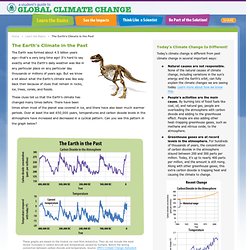
It's hard to say exactly what the Earth's daily weather was like in any particular place on any particular day thousands or millions of years ago. But we know a lot about what the Earth's climate was like way back then because of clues that remain in rocks, ice, trees, corals, and fossils. These clues tell us that the Earth's climate has changed many times before. There have been times when most of the planet was covered in ice, and there have also been much warmer periods. Over at least the last 650,000 years, temperatures and carbon dioxide levels in the atmosphere have increased and decreased in a cyclical pattern. These graphs are based on the Vostok ice core from Antarctica. People didn't cause the climate change that occurred thousands or millions of years ago, so it must have happened for other natural reasons.
The Ozone Hole Tour : Home Page. Mysteries of the Sun: Ionosphere Troposphere and Mesosphere. Www.epa.gov/climatestudents/documents/temp-and-co2.pdf. Www.epa.gov/climatestudents/documents/corals-and-chemistry.pdf. 1 - The Freshwater Life. 1 - Small Freshwater Organisms Giorgio Carboni, December 2006 Translation edited by Sarah Pogue, December 2009 This article is the first in a series devoted to observations using a microscope and deals with the microscopic forms of life that inhabit mainly freshwater ecosystems.
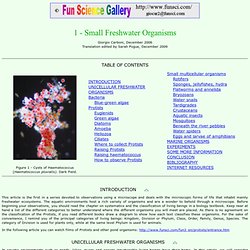
The aquatic environments host a rich variety of organisms and are a wonder to behold through a microscope. Before beginning your observations, you should read the chapter on systematics and the classification of living beings in a biology textbook. Keep near at hand a list of the different categories to better understand where the different organisms you will meet are placed. In the following article you can watch films of Protists and other pond organisms: In aquatic environments such as ponds, lakes, rivers and oceans innumerable living beings have their home. To observe Protozoa and unicellular Algae with a microscope is similar to undertaking a journey to another planet. BACTERIA (Kingdom) PROTISTA (Kingdom) Thirstin's Water Cycle. Www.elginacademy.co.uk/wp-content/uploads/2012/09/3-Abiotic-and-Biotic-Factors-activity-3.pdf.
Www.glencoe.com/sites/common_assets/science/virtual_labs/CT08/CT08.html. The Water Cycle Rap (with lyrics) Instructor Main. Investigating Crickets Unit. Smallin Civil War Cave - Located south of Springfield, MO off highway 65. Environmental Science 101: Interactive Labs for Advanced High School Classes. Modules & Activies Main Page. Using climate science models and NASA satellite images and data sets, students apply problem-solving methods and scientific inquiry skills to address six climate-related scenarios.

More Each of the problem-based learning scenarios also includes teacher pages to help educators implement the modules into their classroom teaching. All of the materials are free. Our only request is that teachers register for the site to access the module-specific teacher pages and complete a post-event survey. More Login Whether you’re new to problem-based learning or have extensive experience using this type of instructional approach, we encourage you to view our problem-based learning pages. The Exploring the Environment legacy modules include four variations on problem-based learning—activities, basic, comprehensive, and advanced. Scientists are explorers. Problem-based learning is designed to stimulate discussion within classes, among teachers, with scientists, and across communities.